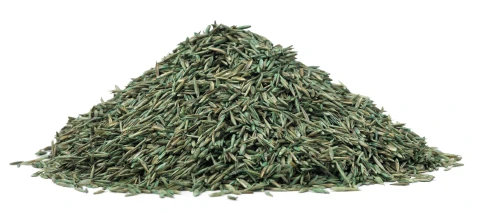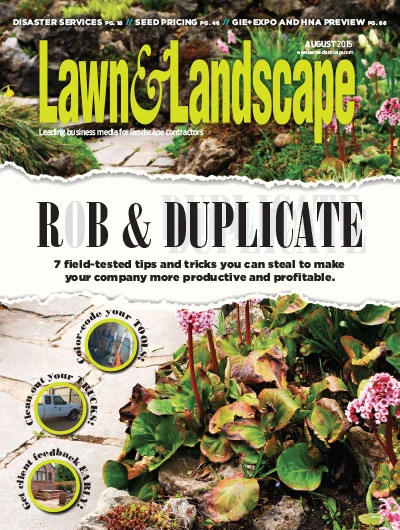
 Despite a hot, dry spring for growers and low carryover stock for suppliers, grass seed prices are stable and they should stay that way, seed companies say. Distributors and suppliers are finally rid of the excess seed they carried during and after the recession, pushing prices higher than they were five years ago, but now they’re staying steady.
Despite a hot, dry spring for growers and low carryover stock for suppliers, grass seed prices are stable and they should stay that way, seed companies say. Distributors and suppliers are finally rid of the excess seed they carried during and after the recession, pushing prices higher than they were five years ago, but now they’re staying steady.
Ebb and flow.
The markets are good, meaning carryover stock is low when it comes to elite and sod quality varieties. “There’s not really anybody that’s overstocked,” says Russ Nicholson, senior agronomist with Pennington Seed.
Tall fescue and ryegrass prices are up slightly due to a shortage of stock last year at Pennington, Nicholson says, adding that seed companies would like to get more inventory.
Pure Seed, however, had carryover of tall fescue last year which reduced prices a little. But salesperson Russ Hayworth says a 20-25 percent lighter than average harvest this year should even prices out.
Nicholson recommends booking good quality seed sooner rather than later due to availability. Many suppliers completely sold out last spring as farmers diversified their crops. In eastern Oregon and Washington, and in the Willamette Valley, other agricultural crops like hazelnuts and blueberries are gaining popularity.
Hayworth, however, says he doesn’t believe the loss of acres will have an effect on grass seed prices. “There’s always acres for grass seed it seems like,” he says. “It took a dent in it, but nothing that we’re seeing affects pricing or quality or anything like that. It just opens up different options for growers.”
But Nicholson believes that has pushed the price of seed up. “The farmer is a businessman,” he says. “They will put in what they can make the most money on and consequently to get them to grow turfgrass has become more and more expensive.”
That has pushed the price of seed higher than it was five or six years ago, but the economic recovery has also depleted overstock left when the market crashed in 2008. When the recession hit, seed production was at an all-time high, Nicholson says, and there was nowhere to sell it.
In Oregon, there weren’t a lot of alternative crops at the time and since grain prices weren’t good, farmers wanted to plant grass. “They wanted to plant more acres and, as an industry, honestly, we didn’t have a lot of self-control so all of us out there thought we could increase our sales by 20 percent,” says Aaron Kuenzi, executive vice president of Mountain View Seeds. “Well, obviously, only one company can increase their sales by 20 percent.”
Since farmers are usually under three- or five-year contracts, the seed kept coming in and distributors’ warehouses were filling up. Some companies even paid farmers to take grass out and it took until about 2013 for the inventory to clear out.
Dealing with drought.
As the drought continues in California, lawns are losing popularity, freeing up some seed for other parts of the country where the market is strong.
But with reduced yields due to a very hot, dry spring and summer, Hayworth says the factors should offset each other and prices will stay the same.
“Perennial ryegrass inventory before the new crops is limited,” he says. “Then again, the good crop perennial is going to be on the lighter side so I think demand will stay strong and pricing will stay the same or maybe slightly higher than last year due to a shorter crop.”
High temperatures in early June stressed crops and stunted normal growth, Hayworth says.
He predicts lower yields this year due to undeveloped and small seeds, meaning more seeds per pound. In areas of California where irrigation is not allowed, yields are low, so Bermudagrass and Kentucky bluegrass have been hit the hardest, Kuenzi says.
“The expectation in the industry three months ago was that prices could soften but because of the drought and the dry weather right now, we’re saying you won’t see a lot of softening happening. You’ll just see stable prices,” he says.
“Depending on how bad this drought is and how long it continues, there’s a chance you could even see prices strengthen a little bit because seed’s not available.”
Looking forward.
Elite and sod-quality varieties are getting harder to come by, partly because it’s getting harder to achieve high quality, Hayworth says. The sod market has been strong in the last year and a half, which means sod producers are buying the best materials.
The trend of the future is drought-tolerant varieties, according to Hayworth. He’s seeing an increased interest in varieties approved by the Turfgrass Water Conservation Alliance.
Nicholson says there has been a lot of development in coated seeds to not only help with germination, but also establishment, nutrient management and more.
“I see more of that going into the professional market,” he says. “In the retail market, that seems to be becoming the norm.”
Aerator/Dethatcher Roundup
Classen TA-17D
 The pitch: Classen PowerSteer Aerators feature split-drive technology, allowing you to steer, turn and aerate an entire job without removing the tines from the ground.
The pitch: Classen PowerSteer Aerators feature split-drive technology, allowing you to steer, turn and aerate an entire job without removing the tines from the ground.
- For non-stop aeration, it has “all-tine” propulsion, meaning every tine is used to propel the unit forward or in reverse.
- It has a 16.25-inch aerating width and is able to cover 19,333 sq.ft/hr.
For more information: Classenturfcare.com
Exmark 30-inch Stand-on Aerator
 The pitch: The Exmark 30-inch Stand-on Aerator features a split-tine design to allow easy turning with tines engaged.
The pitch: The Exmark 30-inch Stand-on Aerator features a split-tine design to allow easy turning with tines engaged.
- 7.5-mph top speed
- Mass is centralized directly over the 48 coring tines for maximum core depth consistency, which is adjustable from 2 to 5 inches.
For more information: Exmark.com
Sponsored Content
A Secret Weapon for Growing Your Lawn Care Business
Retargeting ads allow you to re-engage visitors who leave your lawn care website without converting, helping you stay top-of-mind and increase leads. This article explains how retargeting works, why it’s effective, and how to implement it for your business.
Complete Online Marketing Solutions
Ryan Ren-O-Thin Power Rake
 The pitch: Remove thatch buildup with the redesigned Ren-O-Thin Power Rake.
The pitch: Remove thatch buildup with the redesigned Ren-O-Thin Power Rake.
- •Features interchangeable, high-carbon steel reels for quick customization.
- An ergonomic, multi-position handle can also be adjusted for user comfort.
- Users can fine-tune depth from 1 inch above the ground to 7/8-inch below.
For more information: Ryanturf.com
Toro 30-inch Stand-On Aerator
The pitch: Toro 30-inch stand-on aerators combine heavy-duty commercial durability with features that make any aeration job easier.
- Has ground speeds of up to 7.5 miles per hour and the ability to adjust plug length on the fly.
- Also features an ergonomic foot pedal that raises and lowers tines easily.
- The floating operator platform isolates vibrations, reducing operator fatigue and ultimately increasing jobsite productivity.
For more information: toro.com
Turfco TurnAer XT5
The pitch: Turfco’s TurnAer XT5 steerable and reversible aerator now offers increased speed, a new weight system and a new gear ratio system, improving efficiency and hill performance.
- The weight system allows operators to adjust weight in the back of the aerator, improving control on hills, and the gear ratio system gives operators 14 percent more speed.The TurnAer XT5 also uses Turfco’s steerable aerator technology with a new variable-speed hydrostatic drive system.
- Operators can steer and reverse with tines in the ground eliminating need to stop, lift and turn with each pass.
For more information: turfcodirect.com
Get curated news on YOUR industry.
Enter your email to receive our newsletters.
Explore the August 2015 Issue
Check out more from this issue and find your next story to read.
Latest from Lawn & Landscape
- Ignite Attachments introduces tree and fence post puller
- Landscape Workshop acquires 2 in Virginia markets
- Schill Grounds Management acquires Elevations Landscaping
- Central Turf & Irrigation rebrands as Central Pro Supply
- That's a wrap on the Business Builders Summit
- Our May issue is live
- The 2025 Top 100 List
- Fresh faces to the list








